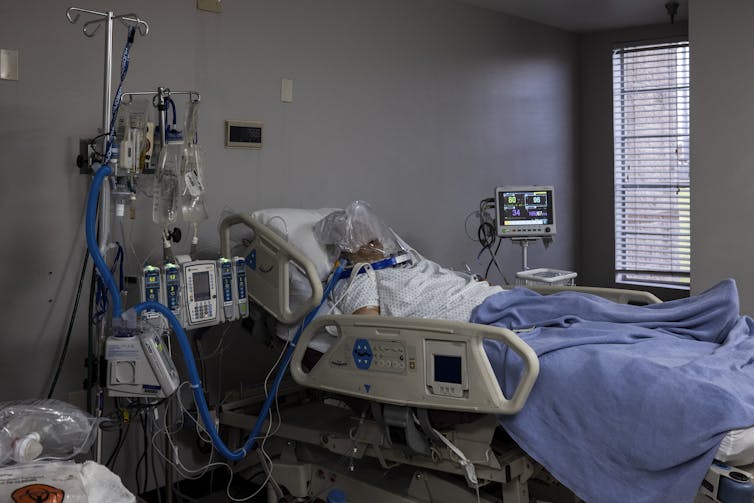Imagine going to the doctor for a cough and getting a transfusion of blood from a goat. It probably sounds strange today, but that is exactly how antibody therapy started in the late 1800s.
Researchers found that plasma, the part of blood left when you get rid of the cells, had healing properties. In fact, the first Nobel Prize in physiology or medicine was awarded to Emil von Behring in 1901 for his work using this approach to treat diphtheria.
Today, scientists understand healing properties of plasma come from antibodies, which are proteins in the blood that recognize and destroy foreign invaders. The goal of a vaccine is to induce the body to make more of these protective antibodies, and lessen the severity of the infection or prevent it all together. As Americans wait for a COVID-19 vaccine, antibody therapy provides a potentially effective treatment option – but one which warrants further study.
As a physician-scientist in pulmonary and critical care medicine, I take care of patients with lung diseases and those who are critically ill in the intensive care unit. I also study the role of antibodies and the cells that make them, called B cells, in lung disease. So when the worst public health crisis in a hundred years struck in my first year out of training, like many of my colleagues I saw it as a call to arms. This is why we became doctors.
The most efficient laboratory – your own immune system
Since von Behring’s pioneering work, antibodies have been used to treat a variety of different infections. This approach waned with the advent of antibiotics in the 1930s.
In the case of epidemics of novel infections, antibodies have reemerged as a therapeutic partly due to one factor: time. Developing a drug in the laboratory takes a long time. In the case of antibodies, the human immune system does this for us. Our bodies are equipped with an astounding repertoire of B cells capable of making up to one quadrillion different antibodies.
Each one of these antibodies can recognize different parts of an infection. When a B-cell recognizes a virus like SARS-CoV-2, which causes COVID-19, as foreign, that B cell makes antibodies which then float around in the blood, binding to the viruses and protecting us from infection.
Three to four weeks after a person recovers from the infection doctors can harvest these antibodies in what is known as convalescent plasma. If effective, this provides a fast track to treatment.

Opportunity in crisis
Convalescent plasma has been tried in recent epidemics such as SARS, MERS and Ebola. In each case, there has been at least some evidence that the treatment is safe and may be effective.
Fortunately for humanity, these outbreaks have been relatively limited in scope, preventing the kinds of numbers necessary in clinical trials to demonstrate that a treatment works. The COVID-19 pandemic, as devastating as it has been, provides a unique opportunity to study whether convalescent plasma is effective.
The pandemic was a chance to do important work to understand the biology of the disease and how to treat it. I am now helping to establish and lead a trial testing the effect of convalescent plasma in COVID-19 patients.
In our trial, my colleagues and I have targeted patients who are hospitalized but not yet critically ill. We hope to test whether convalescent plasma can prevent the progression of this disease to critical illness and death. Entering into the sixth month of this pandemic, we have now completed enrolling patients for the trial and our analysis is underway.
Hopefully in the coming months this trial will help determine whether convalescent plasma is an effective treatment for some patients with COVID-19. Importantly, we will not only evaluate the clinical outcomes, but we will also study the immune system responses to convalescent plasma so we can better understand the underlying mechanisms by which it impacts disease.
Early studies show promise
Several studies have already shown promise for convalescent plasma in COVID-19. A retrospective study from investigators in New York as well as a prospective study out of Houston suggest that convalescent plasma may be effective, particularly when given early before the patient is on a ventilator. Additionally, in a recent report from the Expanded Access Program for convalescent plasma, an analysis of over 35,000 transfused patients showed that earlier transfusion with higher concentrations of antibodies was associated with improved outcomes.
[Deep knowledge, daily. Sign up for The Conversation’s newsletter.]
Convalescent plasma is also the foundation upon which specific antibody therapy is based. In specific antibody therapy, the specific neutralizing antibodies present in convalescent plasma that bind to the virus are isolated and then synthesized in the lab. This has been shown to be effective in the case of Ebola. Researchers have now isolated these neutralizing antibodies for COVID-19, and clinical trials are underway to test their efficacy as well.
These studies and ours provide important steps in developing therapeutics. But even during the urgency of a pandemic it is critically important to perform large, randomized phase 3 clinical trials before changing clinical practice. In support of this the Food and Drug Administration recently halted its emergency use authorization of convalescent plasma, citing a lack of strong evidence. Only by following these rigorous standards of evidence can we finally answer the question: Does convalescent plasma work? In this case, no goat’s blood needed.
Post a Comment